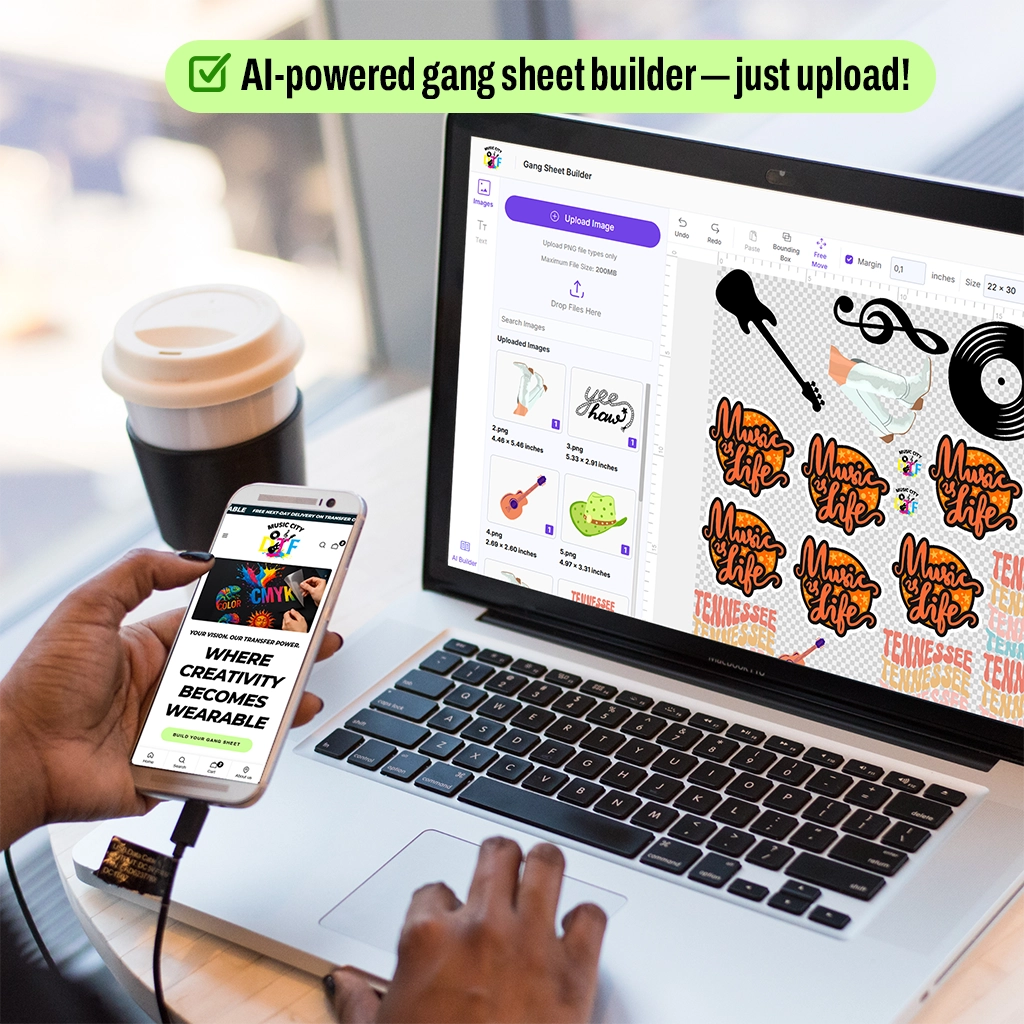In 2025, direct-to-film (DTF) printing is undergoing significant changes due to advancements in automation, materials, software, and consumer demand. DTF printing trends are for everybody in the apparel business, and that’s why it’s super important that you stay up to date. To help you stay current here's what's making DTF different and how to stay ahead in the future of DTF printing.
5 DTF Printing Trends in 2025
1. Smarter, Faster Machines
DTF printers are becoming faster and more reliable. They're putting out double and triple-head machines to make things faster. The mixed printing, applying powder, and drying processes are all combined into one seamless operation. Many printers, such as Music City DTF, offer computer assistance for setting up and resolving issues, resulting in fewer mistakes and easier maintenance. This type of advanced DTF equipment is raising the bar for shops of all sizes.
Additionally, rolling systems are gaining popularity, especially in applications that require rapid delivery. These reduce the amount of work that people have to do by hand and make it easy to print materials when requested. Moreover, smaller tools, such as powder applicators and heat presses, are introducing good business practices to small brands.
2. Eco-Friendly Stuff
Being eco-friendly is not just a trend; it's become vital. Inks are now increasingly water-based, with fewer harsh chemicals. Films are getting thinner, easier to recycle, and can even break down naturally. Powders are becoming eco-friendly too.
This all fits with DTF printing trends 2025, where the push is to use greener options across the DTF in apparel industry. Energy-saving drying ovens and heat presses are also emerging to reduce costs and help the planet.
3. More Materials and Cool Effects
DTF can now print on more than just shirts. New materials make it easy to print on items like leather, wood, pottery, and sportswear. With the rise of automation in DTF printing, these new materials are easier to handle at scale.
Special transfers, such as glow-in-the-dark, color-changing, shiny, glitter, rough, or bouncy finishes, allow people to get extra creative and stand out. This variety connects strongly to DTF market growth forecasts that show continued expansion.
4. Software and Computer Help
Computer programs are enhancing colors, reducing waste, and accelerating processes. They can match colors, set up profiles, check quality as you go, and ensure everything is correct. This supports the use of eco-friendly DTF materials, as there’s less waste.
Additionally, auto-print lines, online tracking, and online store connections make things smoother from the moment someone orders to when it's completed. Together, these create low-minimum DTF runs that are easier to manage profitably.
5. On-Demand Prints
There's a bigger need for small runs and one-of-a-kind prints, even among small businesses and designers. DTF is great because there are no setup costs, it's fast, and it gets the details right. That’s why UV DTF printing is also getting attention, since it brings flexibility and special effects into this mix.
Easy-to-store transfers also help with printing on demand, far away. This makes things easier and lowers waste, part of sustainable DTF workflows that shops are adopting.
6. Better Quality
Print quality is getting better. New print head tech and programs lead to finer prints that look good. This is fueling DTF print-on-demand growth as customers expect higher resolution and cleaner designs.
Inks and coatings are continually improving in terms of adhesion, flexibility, color retention, and durability, enabling prints to remain visually appealing even after extensive use. With high-speed DTF heat press systems, the finishing process is faster without compromising detail.
Why Choose Music City DTF for DTF Printing
At Music City DTF, we understand what it takes to build a successful brand. With state-of-the-art equipment, high-quality materials, and an experienced staff, we ensure that you receive premium service and the best quality for your investment, without the complications typically associated with traditional printing.
Get a taste of Music City’s quality with our free DTF Sample Pack and start printing today!
Frequently Asked Questions
1. How's DTF different from DTG or screen printing?
DTF uses film transfers, unlike DTG's direct method or screen printing's stencils. This way, you can apply designs to a wide range of fabrics and materials. It doesn't cost a lot for small batches, the colors pop, and it's quick to get started, which is great for custom stuff and low-minimum DTF runs.
2. Is DTF printing good for the planet?
Yeah, being green is getting more attention with DTF. New inks made from water, powders that break down naturally, and films that can be recycled are becoming available. Additionally, newer heat presses and ovens consume less power. This shift supports eco-friendly DTF materials and promotes sustainable DTF workflows that reduce waste and energy use.
3. How long do DTF transfers last?
DTF prints are pretty tough; they can go through many washes and still look bright and stretchy. Better inks and powders make them less likely to crack, fade, or peel. If you do it right with the right heat and pressure, DTF transfers can often last longer than vinyl, and high-speed DTF heat press systems help ensure durability and consistency.
4. Can you use DTF printing on things other than clothes?
For sure. It's good for t-shirts and hoodies, but DTF transfers can stick to things like leather, canvas, wood, and even pottery. Special glues and textures let you get creative. Combined with UV DTF printing, shops and designers can expand into décor, accessories, and promo products, which highlights the flexibility of DTF in apparel industry and beyond.
5. Can small businesses make money with DTF printing?
Definitely, DTF is beneficial for profits because it doesn't require a significant investment to get started, and you can achieve a lot with it. Unlike screen printing, you don't have to order a ton at once or set up heavy equipment. Small shops can do custom orders quickly, and the DTF print-on-demand growth is proof that small businesses can benefit from DTF market growth forecasts.





